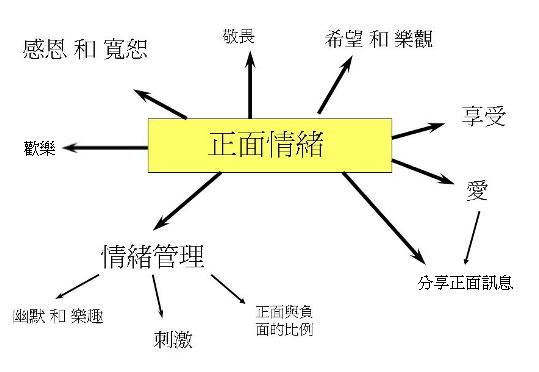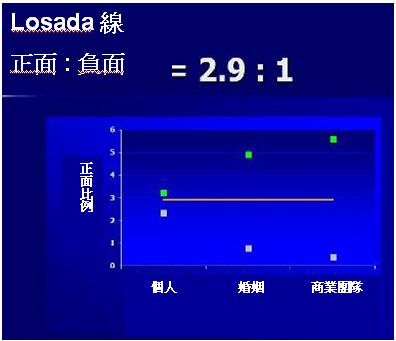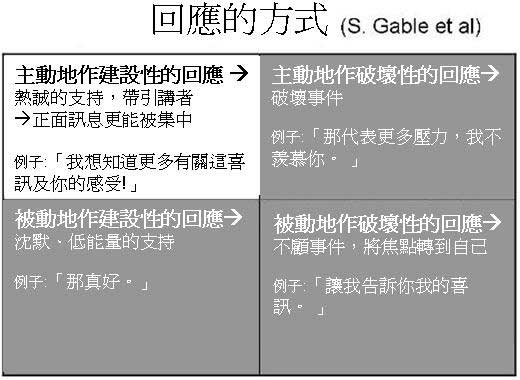正面情绪图像
刘碧琪, 苏德中 译
以下图像展示了一些与正面情绪有关的命题,以及作为相关的正面心理学日报(PPND) 有关正面情绪的文章阅读指南。字型越大,是我们作者越经常撰写的命题。我们将会随着更多文章不断地刊登而每季更新字型。
图中的每个命题都连结至一个简介、相关正面心理学日报文章以及其它主要数据,以便读者更深入了解正面情绪。

正面情绪概论
Barbara Fredrickson的开展与建设理论(Broaden-and-Build theory)是正面心理学其中一个基础。她的理论目的是解释正面情绪对人类心理健康的贡献。负面情绪,例如恐惧、愤怒和憎恶,会导致只着重于避免或面对威胁的挟窄响应。另一方面,正面情绪,会带来认知的灵活性和广泛类别的行为倾向。情绪或者是短暂的,但随行为倾向而来的行为会带来长久的能力,如社交联系和扩展的技能。下列显示一些与正面情绪有关的行为倾向:
欢乐 → 玩乐有趣 → 探索
满足 → 享爱 & 融入骄傲→ 追求大梦想感恩 → 创新的付出提升 → 做得更好爱 → 以上皆是在每一位PPND作者的心里,都有开展与建设理论(Broaden-and-Build theory)的基础支持,这尤其反映于他/她写及正面情绪时。
据Ed Diener指出,主观的心理健康(subjective well-being)由三个质素影响:正面情绪的数量(amount of positive affect),负面情绪的数量(amount of negative affect)和整体对人生的满意度(overall satisfaction with life)。他认为正面和负面情绪独立地变代,而非同一刻度上的两端。有可能同时拥有高正面及负面情绪或两者同时都低。人生的满意度是一个对一般人生处境比较长远的评估。PANAS 问卷是以这种方式来特写主观心理健康,而在Authentic Happiness网站登记后供免费使用。
正面情绪概论的资料Diener, E. (2000). Subjective well-being: The science of happiness and a proposal for a national index. American Psychologist, 55, 34-43.Diener, E., Suh, E., & Oishi, S. (no date).Recent findings on subjective well-being.Fredrickson, B. (1998). What good are positive emotions? Review of General Psychology, 2, 300-319.Fredrickson, B. (2001). The role of positive emotions in positive psychology: The broaden-and-build theory of positive emotions. American Psychologist, 56, 218-226.Barbara Fredrickson’s Web site: The Broaden-and-Build Theory返回图像
正面与负面的比例
研究员指出正面与负面的比例 (PNR)与不同处境的结果,包括婚姻和商业团队,有强烈的关系。例如,美满的婚姻倾向得到较高正面与负面的比例(根据Gottman的研究是大于5比1),而失败的婚姻倾向得到较低比例(少于1比1) 。以下展示的 Losada线以Marcial Losada命名,是一条记录不同结果数据的线,显示丰盛和萎谢结果的分界(Fredrickson & Losada, 2005)。虽然很难想象一段婚姻或一支商业团队会有一个记分员负责监察PNR,但不容置疑PNR的发现有助人们努力营造更有效的比例。

返回图像
享受
根据Fred Bryant & Joseph Veroff的研究(2007),享受包含了细味和欣赏生命里正面的范畴 — 适应力的正面对应。享受大于快乐 — 它包括了细心以及「有意识地留意快乐的经验」(p. 5)。 你可以有共鸣地享受—分享自己及他人的快乐。
许多享受的过程都可以调节其它正面经历(p. 14): 下列是其中几项:
惊讶调节敬畏 (Marveling regulates awe)感谢调节感恩 (Thanksgiving regulates gratitude)感到适意调节骄傲 (Basking regulates pride)闲来享受调节生理乐趣 (Luxuriating regulates physical pleasure)以享受为例子的PPND 文章Savoring for your health!(Doug Turner)The Delight and Discontent of Eating(Gloria Park)The Digital Scrapbook/Portfolio: Self-reflection, Savoring, and Well-being(John Yeager)On Adventure and Filet Mignon(Derrick Carpenter)Mozart and Minidiscs(Derrick Carpenter)Making Space for Children’s Well-being(Bridget Grenville-Cleave)On Contentment(Miriam Ufberg)On Savoring(Miriam Ufberg)The Power of Touch beyond Pain and Pleasure(Iris Marie Bloom)Nature and Nocturnal Themes in Positive Psychology(Iris Marie Bloom)Positive Psychology, Party of Two(Amy Donovan)How Anticipation Can Save the Day(Aren Cohen)其它有关享受的资料
Bryant, F. & Veroff, J. (2007).Savoring: A new model of positive experience. Mahwah, NJ: Lawrence Erlbaum Associates.返回图像
爱
爱被理论家如Fredrickson & Branigan (2001)和Vaillant (2008)视为正面情绪之一。爱与被爱的能力是24项VIA性格能力之一,可以带给我们 满足和真正的快乐(Seligman, 2002)。根据Fredrickson & Branigan,爱的体验是由无数正面情绪所造成,例如兴趣、欢好和满足感。爱不只产生这些正面情绪,「当人们与心爱的人探索、享受和玩乐,爱亦开展了思考/行动技能。」 (p.132) 爱作为正面情绪建立和巩固我们的社交资源。
当我们谈及爱,我们通常会立即想到浪漫的爱情。可是,我们的爱不只局限于对我们的伴侣。我们可以爱我们的家人、朋友和任何人。所有形式的爱都会带来正面情绪。
Chris Peterson所说的「其它人很重要」也许是正面心理学其中一个主要的信条。其实人际关系是大部份人最为关切的,是研究The Life Worth Living的直接基础,而非间接的促成因素。我们正制作另一张有关正面人际关系的图像并不日推出,现暂将爱收录在此作为正面情绪的主要要素。
探究爱的PPND 文章“I’ve Got a Name”- The Power of Positive Salutating(John Yeager)What is Love Anyway?(Aren Cohen)The Meaning in Mother’s Day(Giselle Nicholson)Using the ‘L’ Word in Business(Margaret Greenberg)Love and the Capacity to Love(Margaret Greenberg)Other People Matter(Dave Shearon)Advice from the Tribesman: Too Simple for the World?(Lucy Ryan)Let’s Talk About Sex(Cassie Robinson)How Do You Share Positive Psychology with Strangers?(Sulynn)Positive Psychology: Party of Two(Amy Donovan)Lessons from the Earthquake: Altruism and Selfless Love(Timothy T.C. So)Read this Book! “Spiritual Evolution” by George Vaillant(Senia Maymin)其它有关爱的资料
Dutton, J. (2003).Energize your workplace: How to create and sustain high-quality connections at work.San Francisco: Jossey Bass.Fredickson, B. L, & Branigan, C. (2001). Positive emotions. In T. Mayne & G. A. Bonanno (Eds.),Emotions: Current Issues and Future Directions(pp.123-151). New York: Guilford Press.Gottman, J. M. & DeClaire, J. (2001).The relationship cure: A 5 step guide to strengthening your marriage, family, and friendships.New York: Three Rivers Press.Gottman, J. M. & Silver, N. (1999).The seven principles for making marriage work.New York: Three Rivers Press.Lyubomirsky, S. (2008).The how of happiness: A scientific approach To getting the life you want.New York: Penguin Press.Peterson, C. & Seligman, M. E. P. (2004).Character strengths and virtues, pp. 303-324. New York: Oxford PressVaillant, G. (2008).Spiritual life: A scientific defense of faith.New York: Broadway Books. Chapter 5.返回图像
分享正面讯息 (Capitalizing & ACR)
Capitalizing是指与信任的人分享正面的讯息。Gable et al发现人较多记住正面的讯息,在他们的思想中较突出,而它对一般心理健康有更大的影响。
主动地作有建设性的响应(Active constructive responding)是四种方式去回能别人的其中之一。(请参考以下图例)
主动地作有建设性的响应是指与其它人合作去帮助他们收集喜悦 — 通过提出问题去令他们思考更多有 关正面的事件。所有其它的响应方式都倾向产生负面影响,被动地作建设性的响应亦然,因为它令人泄气。

其它有关分享正面讯息的数据
Gable, S., Reis, H., Impett, E., and Asher, E. (2004). What do you do when things go right? The interpersonal and intrapersonal benefits of sharing positive events. Journal of Personality and Social Psychology. Vol 87(2), 228-245.Active & Constructive Responding: A Clip from Reflective Happiness — Youtube of Martin Seligman SpeakingCoaching toward happiness– Scroll down this page until you find the title, Shelly and Me, which introduces a good summary of Shelly Gable’s work.返回图像
希望和乐观
根据Snyder的希望理论(Hope Theory),希望是一个目标导向思考的过程,同时反映一个人可以找到通往目标的路向,以及因个人才能而异的推动力或动力思考。
乐观受解释形态(explanatory style)的强烈影响,即是一个人如何习惯性地解释正面及负面的事情。Sandra Schneider定义现实的乐观为当一个人拥有解释的自由时会选择正面解释的倾向。
希望和乐观同样是我们在认知、情绪和推动力上对未来的态度,象征着未来的好事会多过坏事的一个信念(Peterson & Seligman, 2004, p. 572)。希望和乐观也是24项VIA性格能力之一。
乐观是其中一个质素符合加入Luthans, Youssef, & Avolio的心理资本模型(psychological capital model)。详情请参阅Dave Shearon的书评。
关于希望和乐观的PPND 文章Responding Well(Doug Turner)Sustainability: From Denial and Depression to Hope and Personal Responsibility(Kathryn Britton)The Perils of Pollyanna(Dave Shearon)Optimists in Law School(Dave Shearon)Sure They’ll Think You’re Smart. But Will They Want to Work for You?(Dave Shearon)Psychological Capital – PsyCap(Dave Shearon)Music and Songs: The Sounds of Hope?(Bridget Grenville-Cleave)其它有关希望和乐观的资料
Luthans, F., Youssef, C., & Avolio, B. (2006).Psychological capital: Developing the human competitive edge.Oxford University Press.Peterson, C. & Seligman, M.E.P. (2004).Character strengths and virtues.Oxford University Press. PP. 569-582.Peterson, C. & Steen, T. (2005). Optimistic explanatory style. In C. R. Snyder & S. Lopez,Handbook of Positive Psychology, pp. 244-265. Oxford University Press.Schneider, S. (2001). In search of realistic optimism: Meaning, knowledge, and warm fuzziness. American Psychologist. 56, 3, 250-263.Seligman, M. E. P. (2006).Learned optimism: How to change your mind and your life.Updated edition with new preface. New York: Vintage Press.Snyder, C. R. (2002). Hope theory: Rainbows in the mind. Psychological Inquiry, 13(4), 249 – 275.Snyder, C. R. (2005). Hope theory: A member of the positive psychology family. In C. R. Snyder & S. Lopez,Handbook of Positive Psychology, pp. 257-276. Oxford University Press.返回图像
情绪管理
正面情绪是如此短暂,但受它们所影响的心情却会维持一段长时间。关于如何变得更快乐的书籍通常会包含了正面治疗去准备缩短负面心情和廷长正面心情。
关于情绪管理的PPND 文章Feel Better Faster, Learn More Effectively: Use Your Mood Repair Toolkit(Sherri Fisher)Is Feeling Better as Easy as ABC?(Nicholas Hall)The A.P.E. Method to Get Out of a Bad Mood(Senia Maymin)It’s Not That Easy Being Green: The Treadmill of Sustainable Happiness in the Holidays and Beyond(Sherri Fisher)Social Contagion: Spiral Up or Spiral Down?(Kathryn Britton)Taking Positive Psychology to Work: The Reframing Skill(Kathryn Britton)Self-Talk: A Positive Intervention Under Construction(Kathryn Britton)Physical Activity and the Good Life(Gloria Park)How to Be Happy at College and Beyond! Notes from One Mom to a College Freshman(Caroline Miller)Living in the No-Regrets Zone(Caroline Miller)Retrospective Visualization(Giselle Nicholson)ABC’ing Parental Involvement(Dave Shearon)On a Grumpy Day(Dave Shearon)The Three Bears(Dave Shearon)Do Not Take the Contemplative Panic!(Angus Skinner)Regrets, I’ve Had a Few: How Finding the Silver Lining Contributes to Happiness and Maturity(Bridget Grenville-Cleave)People in Little Boxes on Wheels(Sulynn)其它有关情绪管理的数据Ben-Shahar, T. (2007).Happier: Learn the secrets to daily joy and lasting fulfillment.New York: McGraw Hill.Fredrickson, B. (2001). The role of positive emotions in positive psychology: The broaden and build theory of positive emotions. American Psychologist, 56, 218-226.Fredrickson, B. & Losada, M. (2005). Positive affect and the positive dynamics of human flourishing. American Psychologist, 60, 678-686.Lyubomirsky, S. (2008).The how of happiness. A scientific approach to getting the life you want.New York: Penguin Press.Nezlek, J. & Kuppens, P. (2008). Regulating positive and negative emotions in daily life. Journal of Personality.76(3), 561-579返回图像
刺激和促发
一个管理情绪的好办法是意识到会引发正面或负面情绪的刺激。有了这个认知,就可以避免引起负面情绪的情况,比当它们发生时明白和控制负面情绪更佳,以及找出会产生正面情绪的情况。
关于刺激(正面和负面)的PPND 文章
Let Positive Triggers Turn on Your Best Self(David Pollay)The Positive Psychology of Shopping(Sherri Fisher)Positive Priming(Elizabeth Peterson)Share Your Dreams: Let People Help You(David Pollay)It’s Not a Catastrophe! Don’t Build a Jack Story(David Pollay)返回图像
幽默
据Peterson and Seligman所说,幽默包含了开玩笑的认同和不协调的乐趣,对逆境的光辉面一个乐观的看法,以及使人会心微笑和开怀大笑。 VIA包括了幽默和开玩笑作为24个性格能力之一。
关于幽默的PPND 文章Will my Bat Globe Give Me Longer Life (And Make Me Smile Too)?(Caroline Miller)Happiness and Your License Plate(Caroline Miller)其它有关幽默的资料
Lefcourt, H. (2005). Humor. In C. Snyder & S. Lopez (Eds.),Handbook of positive psychology, pp 619-631. Oxford University Press.Peterson, C. & Seligman, M.E.P. (2004).Character strengths and virtues, pp. 583-598. Oxford University Press. PP. 569-582.返回图像
感恩 & 宽恕
感恩是复杂的。这是一种可以通过有意图的活动来培育的正面情绪。它是一项VIA测验量度的性格能力。它是一些证明会增加快乐的正面治疗的基础。感恩包含了感谢好事的发生 – 在意于当前的利益 — 以及认识好事的外在来源。
宽恕是感恩的反面。它包含了对冒犯的人正面响应,给予怜悯而非报复。正如感恩,它是外在导向和有意图的,以及被列为VIA性格能力。
这里将两项合并,因为它们其同的特征,也因为宽恕还未受PPND作者足够的重视而成为独立的范畴。
关于感恩和宽恕的PPND 文章Increase Your Happiness: Build Gratitude Chains in Your Life(David Pollay)Gratitude and Giving will Lead to Your Success(David Pollay)A Daily Dose of Awe and Gratitude(David Pollay)Create Your Own Happy Hour: Serve 3 for 1 Gratitude(David Pollay)Gratitude at the Bridge House (Or ‘Below Zero’ is a Skewed Term(Nick Hall)Family Holiday Rituals: Continuity and Gratitude(Kathryn Britton)Taking Positive Psychology to Work: The Role of Gratitude(Kathryn Britton)The Gratitude Cruise(Caroline Miller)The Energy of Gratitude(Caroline Miller)Gratitude Day: A New Tradition(Derrick Carpenter)The Miracle and the Irony of Forgiving(Doug Turner)其它有关感恩和宽恕的资料Emmons, R. (2007).Thanks! How the new science of gratitude can make you happier.Boston: Houghton Mifflin.Emmons, R. & Sheldon, C. M. (2005). Gratitude and the science of positive psychology. In C. R. Snyder & S. Lopez (Eds.),Handbook of positive psychology, 459-471, Oxford University Press.Lyubomirsky, S. (2008).The how of happiness. A scientific approach to getting the life you want.New York: Penguin Press.Peterson, C. & Seligman, M.E.P. (2004).Character strengths and virtues, pp. 553-568 and pp. 445-459. Oxford University Press.返回图像
敬畏和提升
敬畏和提升是自我转变的情绪,有可能被见证人性美好或美德所引起,而经常予人不断进步和努力向善的渴望。
关于敬畏和提升的PPND 文章A Daily Dose of Awe and Gratitude(David Pollay)Awe and Elevation(Kathryn Britton)其它有关敬畏和提升的资料Haidt, J. (2006).The happiness hypothesis: Finding modern truth in ancient wisdom.New York: Basic Books.Haidt, J. (2003). Elevation and the positive psychology of morality. In C. Keyes and J. Haidt (eds.),Flourishing: Positive psychology and the life well-lived.Washington, D. C.: American Psychological Association.Keltner, D. & Haidt, J. (2003). Approaching awe: A moral, spiritual, and aesthetic emotion. Cognition and Emotion, 17, 297-314. Retrieved May 7 2007 from http://faculty.virginia.edu/haidtlab/articles/keltner.approaching-awe.pdfVaillant, G. (2008).Spiritual life: A scientific defense of faith.New York: Broadway Books.返回图像
欢乐
George Vaillant指出,欢乐倾向存在于每个人正面情绪的名单上,而它却是最后一个被研究的(2008, p. 119)。欢乐是有别于快乐也和愉快不同(p. 131)。他提到心理学定Sylvan Tomkins的作品,他将欢乐联系到摆脱痛苦。欢乐可以是从束缚中获得自由,重拾失去的事情。欢乐也可以是观察人生中微小但寻常的奇迹,例如看着自己的小孩行第一步。
我们PPND仍未有太多写及欢乐的文章,尽然这是正面情绪的一部份。Barbara Fredrickson将欢乐联系至游戏。George Vaillant将之联系至听贝多芬写于完全失聪时的第九交响曲。
其它有关欢乐的资料Fredrickson, B. (2005). Positive emotions. In C. Snyder & S. Lopez (Eds.), Handbook of positive psychology, pp. 120-134. Oxford University Press.Vaillant, G. (2008). Spiritual evolution: A scientific defense of faith, pp. 119-134. New York: Broadway Books.返回图像
声明:部分文章和图片来源于网络,版权归原作者所有,如有侵权,请联系删除:wzwt58@qq.com 。本站发布此信息目的在于传播更多信息,与本网站立场无关,不保证该信息(包括但不限于文字、数据及图表)准确性、真实性、完整性等。本文地址:https://www.zilezai.com/xlzs/11459.html

